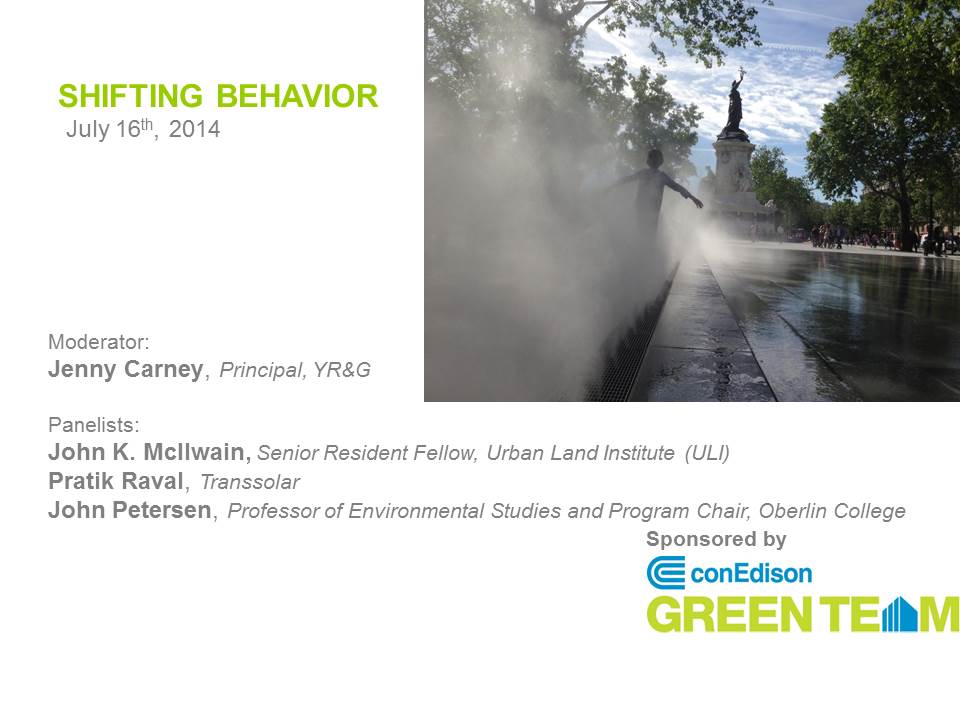by: Graham Higgins LEED AP
People are the key to energy-efficient buildings. As revealed in the 07.16.14 “Shifting Behavior” event, organized by the AIANY Committee on the Environment (COTE), a truly energy-efficient building actively engages its occupants. North Americans now spend 90% or more of their time indoors, and much of the remaining travelling between buildings. The built environment is thus crucial to limiting humanity’s negative environmental impact, but also presents a number of economic opportunities.
Energy conservation can benefit a building’s bottom line through reduced energy expenditure and promote an ethic of environmental conservation through reduced demand for fossil fuels. The technologies and passive design strategies employed in certification systems, such as Passive House, have brought energy-efficient structures into the mainstream at prices that rival conventional construction; however, people will always be instrumental in a building’s success. Some estimates suggest that occupant behavior can influence energy usage by as much as 30 to 50% of overall consumption. As a result, strategies that encourage occupant-driven energy conservation are among the best tools designers have in ensuring buildings and communities remain productive, sustainable, and resilient.
The event’s moderator, Jenny Carney, principal at YR&G, focused the discussion on the interdependencies between individuals, buildings, and the broader natural environment. Carney, who served as a primary author of LEED v2.0, v2008, v2009, and the newly introduced v4 reference guides, stressed energy’s central importance within the high-performance building field. Each of the three speakers approached energy from a unique perspective, collectively highlighting the importance of energy efficiency and the future of the built environment.
The Urban Land Institute’s Senior Resident Fellow for Housing John K. Mcllwain has dedicated more than 35 years to promoting affordable housing solutions designed to create sustainable environments. According to Mcllwain, the key to generating scalable energy efficiency opportunities is to focus on the relationship between technology and occupant: traditional energy efficiency measures, such as programmable thermostats, provide limited benefit without appropriate occupant engagement. Many thermostats are typically incorrectly programmed, inappropriately placed, or improperly maintained, and display little to no information to help reduce excessive energy consumption. Educating building occupants, as outlined in Energy Star’s guidelines, will help ensure proper use and maintenance while creating direct economic benefit. Increased occupant engagement can engender a greater understanding of building systems and an awareness of both limitations and opportunities.
Pratik Raval, a project leader at the German climate engineering firm Transsolar, has worked extensively in developing human-centric solutions with low environmental impact. For Raval, occupant comfort and a sustainable future are inseparable. An energy-efficient structure is one that acknowledges the environmental impacts of maintaining occupant comfort in a cost-effective manner. Occupants must remain both comfortable and aware of the potential negative impacts of their associated energy consumption. As Raval argued, intelligent designs that acknowledge occupant behavior are fundamental to any high-performance structure. Ultimately comfort can be achieved in an environmentally benign and economically productive manner.
John Petersen, program chair of Environmental Studies at Oberlin College and a trained systems ecologist, focused his presentation on the importance of feedback in environmental and social systems. Petersen’s work has revealed that a successful energy efficiency effort involves a multifaceted feedback approach. In order to ensure occupants’ energy conservation efforts are effective, feedback must be readily accessible and provided in a timely and actionable manner. Simple thermostats, for example, provide little more that the device’s perceived current temperature. Feedback that is driven by a combined economic and ethical impetus has the greatest potential of motivating occupants to consume energy more efficiently. An array of tools, such as Lucid Design’s Building Dashboard, which Petersen helped develop, offers innovative strategies to motivate occupants to consume in a more economically- and environmentally-responsible manner.
The challenges the contemporary energy efficiency field faces are part of a larger global dialogue between people, planet, and profit, often referred to as the triple bottom line. Simply put, climate change is an energy-driven issue. While cleaner forms of renewable generation are increasingly popular and available in a variety of cost effective forms, energy efficiency is often overshadowed and undervalued. Energy efficiency will unquestionably play a central role in balancing environmental impact with economic productivity and profit. However, it is crucial to acknowledge energy efficiency’s human dimension, the people who occupy buildings. People are the key to promoting a brighter future through pursuing economically productive strategies in an environmentally responsible manner. As events such as the People’s Climate March and associated New York Climate Summit at the UN continue to reveal, our future is in our hands. The design and architectural community is in a unique position to generate positive change, and energy efficiency is one of the most powerful tools at our disposal.
Graham Higgins is a New York City-based sustainability and resiliency consultant with a particular focus on energy efficiency, renewables and the built environment
Event: Shifting Behavior
Location: Center for Architecture, 07.16.14
Speakers: John McIlwain, Senior Resident Fellow, Urban Land Institute; Pratik Raval, Project Leader, Transsolar; John Petersen, Program Chair, Oberlin College; and Jenny Carney, Principal, YR&G
Organizers: AIANY Committee on the Environment
Sponsors: ConEdison Green Team








